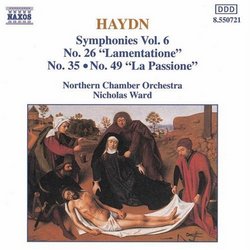| All Artists: Franz Joseph Haydn, Nicholas Ward, Northern Chamber Orchestra Title: Haydn: Symphonies No. 26 "Lamentation", No. 35, N49 "La Passione" Members Wishing: 0 Total Copies: 0 Label: Naxos Original Release Date: 1/1/1993 Re-Release Date: 1/28/1994 Genre: Classical Styles: Historical Periods, Classical (c.1770-1830), Symphonies Number of Discs: 1 SwapaCD Credits: 1 UPCs: 730099572125, 4891030507210 |
Search - Franz Joseph Haydn, Nicholas Ward, Northern Chamber Orchestra :: Haydn: Symphonies No. 26 "Lamentation", No. 35, N49 "La Passione"
 | Franz Joseph Haydn, Nicholas Ward, Northern Chamber Orchestra Haydn: Symphonies No. 26 "Lamentation", No. 35, N49 "La Passione" Genre: Classical
|
Larger Image |
CD Details |
CD ReviewsExploring the Haydn Symphonies -- Nos. 26,35,and 49 Robin Friedman | Washington, D.C. United States | 09/20/2004 (5 out of 5 stars) "In spite of the disparity in their numberings, Haydn composed each of the three symphonies on this CD in 1767 and 1768. Two of the symphonies, nos. 26 and 49, are examples of Haydn's "Sturm und Drang" (storm and stress) period. They both were written, apparently, as religious "passion" music in celebration of Easter. The two symphonies are full of emotion and tragedy and are among Haydn's earliest compositions in the minor key. These two symphonies show well how Haydn was able to take and use the old, even archaic, forms he had inherited even while transforming them with his own creativity. The third symphony on the cd, no. 35, is a lighter, more gallant work.
The symphony no. 26 in D minor, "Lamentation", is in three movements. Karl Geiringer's "Haydn: A Creative Life in Music" observed that "[f]rom the stirring syncopation of the beginning to the passionate lament of the minuet, this work strikes a note of suffering and despair." (p.238) The opening allegro begins with a stern tragic theme followed by a quiet, speaking theme in the major. It features solos in the oboe. The second movement, andante, is quietly meditative. Again, the lead is given to the oboe and other winds. The oboe first sings out over a walking theme in the lower strings and then is counterpointed against a separate theme in triplets in the violins. The movement increases in solemnity and stateliness as it progresses. The final movement is a minor key minuet in the strings with a brief trio in the major in which the strings answer the winds. The work comes to a quiet end. This work is stylistically early, but Haydn infuses it with meaning. The symphony no 49 in F minor is known as "La Passione" This work too is written in a style old in Haydn's time. The first and third movements are slow and the second and fourth movements are fast. The work strikes me as something Gluck might have composed if he had been a symphonist, with its angular, directed themes. Geringer writes of this symphony that "[t]his work displays, particularly in its second movement in F minor, a feverish fierceness of expression that few musical or poetical works of the eighteenth century surpassed." ("Haydn, A Creative Life in Music, p. 239) The opening minor key adagio is in the form of an overture in which the tension slowly builds and develops throughout. The tension finds release in the second movement, allegro di molto, also unremittingly in the minor, which is stormy and passionate throughout. It features large falling intervals in fifths and octaves. The third movement is a slow minuet with a stately, walking theme. The finale, presto, hearks back to the second movement with is swirling intense themes. As did the second movement, it uses wide skips in intervals, in this case ascending octaves. This is a work in the ancient form of a church sonata which Haydn fills with passion and fury. The third work on this CD, the symphony no. 35 in B flat major is a lovely flowing work with little of the storms of its companions. The opening allegro di molto begins with a flowing theme in the strings with accompanying passages for the horn. The horn figures preemininently in the development as well, and in the recapitulation it is featured in passages at the upper limits of its register. The second movement is a flowing andante for the strings. Listeners sometimes overlook how lovely Haydn's slow movements can be. This movement reminds me in its gracefullness of a slow movement from a Mozart piano concerto. The minuet has large passages for winds contrasting with the strings. The trio is in triplets for strings alone, and is based on the minuet proper, at a quicker pace. The finale is a quick, lively celebratory movement for a lyrical and accessible early symphony. This disk is part of a compilation of Haydn's entire 104 symphonies on the budget-priced Naxos label. The Naxos series uses a variety of conductors and orchestras. The performances here are by Nicholas Ward and the Northern Chamber Orchestra. The performances are done with passion and brio. The CD is an excellent introduction to the early Haydn." |

 Track Listings (11) - Disc #1
Track Listings (11) - Disc #1